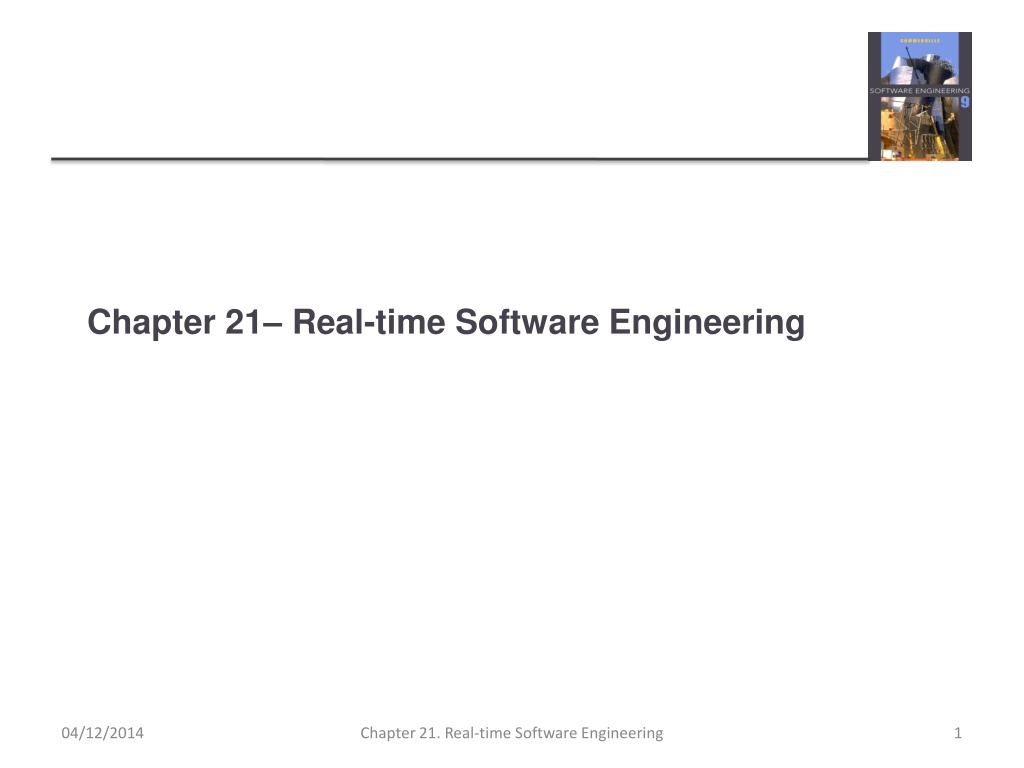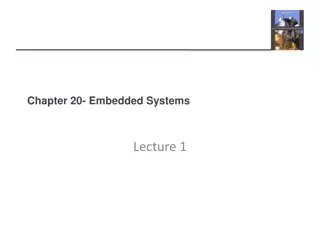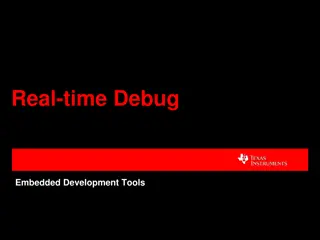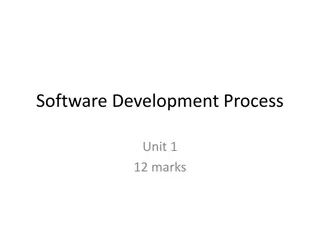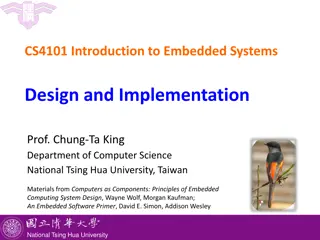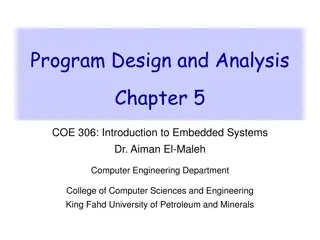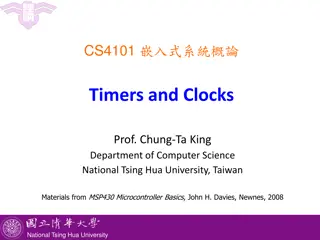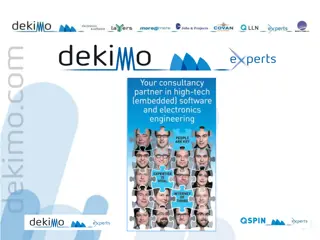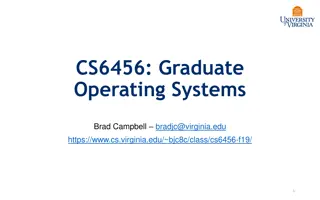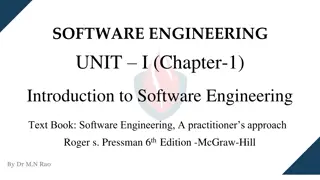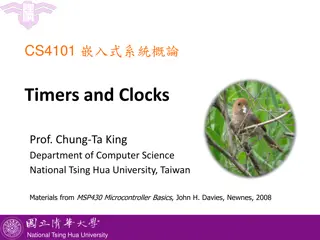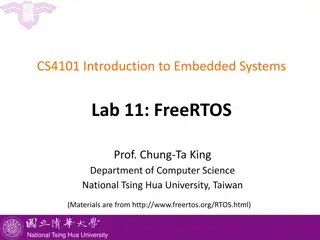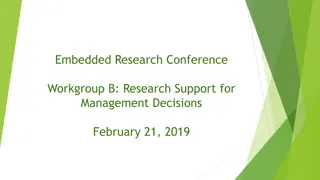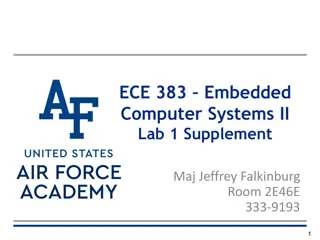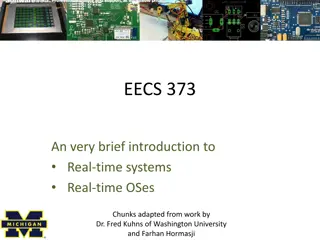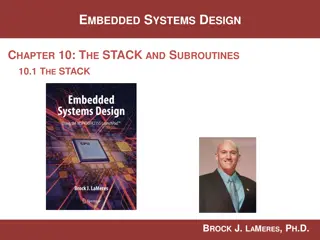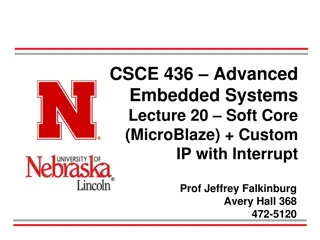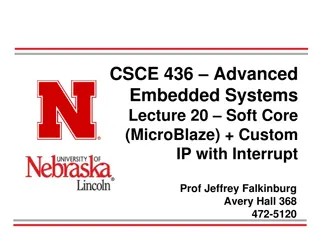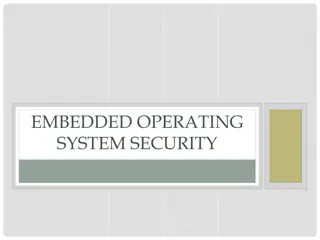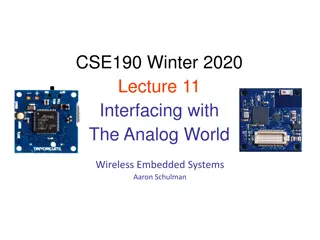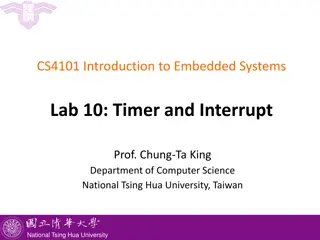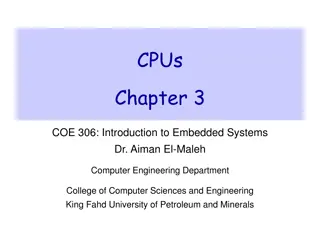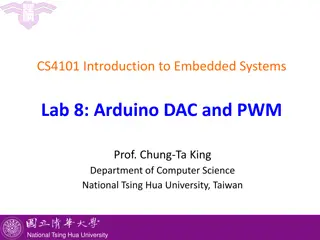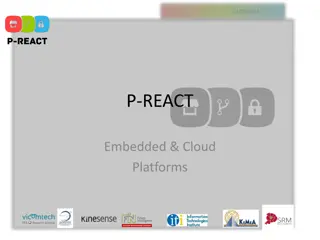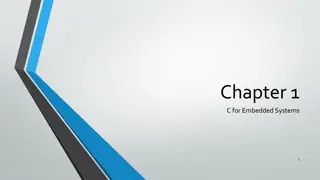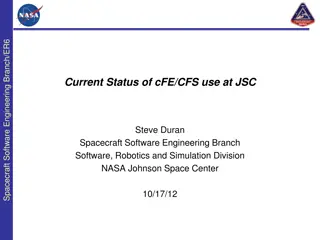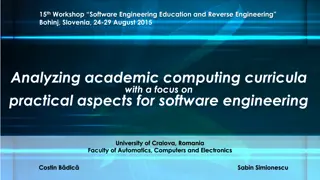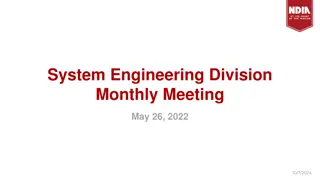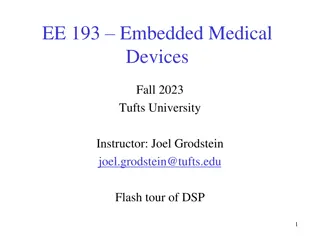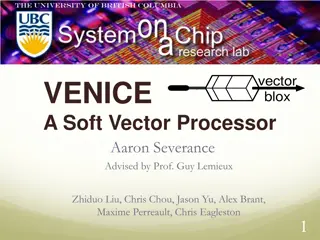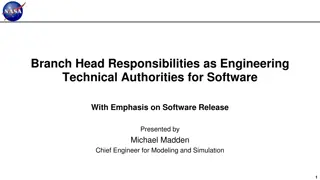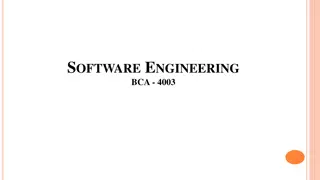Understanding Real-time Software Engineering for Embedded Systems
Embedded systems play a crucial role in controlling various machines and processes. Real-time software engineering focuses on designing systems that respond instantly to events, ensuring correctness and timeliness. Characteristics like continuous operation, unpredictable environment interactions, and safety considerations differentiate embedded systems from other software systems. Designing embedded systems requires careful consideration of hardware integration, timing analysis, and architectural patterns to meet specific requirements.
- Embedded Systems
- Real-time Software Engineering
- System Design
- Timing Analysis
- Architectural Patterns
Download Presentation

Please find below an Image/Link to download the presentation.
The content on the website is provided AS IS for your information and personal use only. It may not be sold, licensed, or shared on other websites without obtaining consent from the author. Download presentation by click this link. If you encounter any issues during the download, it is possible that the publisher has removed the file from their server.
E N D
Presentation Transcript
Chapter 21 Real-time Software Engineering 04/12/2014 Chapter 21. Real-time Software Engineering 1
Topics covered Embedded system design Architectural patterns for real-time software Timing analysis Real-time operating systems 04/12/2014 Chapter 21. Real-time Software Engineering 2
Embedded software Computers are used to control a wide range of systems from simple domestic machines, through games controllers, to entire manufacturing plants. Their software must react to events generated by the hardware and, often, issue control signals in response to these events. The software in these systems is embedded in system hardware, often in read-only memory, and usually responds, in real time,to events from the system s environment. 04/12/2014 Chapter 21. Real-time Software Engineering 3
Responsiveness Responsiveness in real-time is the critical difference between embedded systems and other software systems, such as information systems, web-based systems or personal software systems. For non-real-time systems, correctness can be defined by specifying how system inputs map to corresponding outputs that should be produced by the system. In a real-time system, the correctness depends both on the response to an input and the time taken to generate that response. If the system takes too long to respond, then the required response may be ineffective. 04/12/2014 Chapter 21. Real-time Software Engineering 4
Definition A real-time system is a software system where the correct functioning of the system depends on the results produced by the system and the time at which these results are produced. A soft real-time system is a system whose operation is degraded if results are not produced according to the specified timing requirements. A hard real-time system is a system whose operation is incorrect if results are not produced according to the timing specification. 04/12/2014 Chapter 21. Real-time Software Engineering 5
Characteristics of embedded systems Embedded systems generally run continuously and do not terminate. Interactions with the system s environment are unpredictable. There may be physical limitations that affect the design of a system. Direct hardware interaction may be necessary. Issues of safety and reliability may dominate the system design. 04/12/2014 Chapter 21. Real-time Software Engineering 6
Embedded system design 04/12/2014 Chapter 21. Real-time Software Engineering 7
Embedded system design The design process for embedded systems is a systems engineering process that has to consider, in detail, the design and performance of the system hardware. Part of the design process may involve deciding which system capabilities are to be implemented in software and which in hardware. Low-level decisions on hardware, support software and system timing must be considered early in the process. These may mean that additional software functionality, such as battery and power management, has to be included in the system. 04/12/2014 Chapter 21. Real-time Software Engineering 8
Reactive systems Real-time systems are often considered to be reactive systems. Given a stimulus, the system must produce a reaction or response within a specified time. Periodic stimuli. Stimuli which occur at predictable time intervals For example, a temperature sensor may be polled 10 times per second. Aperiodic stimuli. Stimuli which occur at unpredictable times For example, a system power failure may trigger an interrupt which must be processed by the system. 04/12/2014 Chapter 21. Real-time Software Engineering 9
Stimuli and responses for a burglar alarm system Stimulus Response Clear alarms Switch off all active alarms; switch off all lights that have been switched on. Initiate alarm; turn on lights around console; call police. Console panic button positive Power supply failure Call service technician. Sensor failure Call service technician. Single sensor positive Initiate alarm; turn on lights around site of positive sensor. Initiate alarm; turn on lights around sites of positive sensors; call police with location of suspected break-in. Switch to battery backup; run power supply test. Two or more sensors positive Voltage drop of between 10% and 20% Voltage drop of more than 20% Switch to battery backup; initiate alarm; call police; run power supply test. 04/12/2014 Chapter 21. Real-time Software Engineering 10
Types of stimuli Stimuli come from sensors in the systems environment and from actuators controlled by the system Periodic stimuli These occur at predictable time intervals. For example, the system may examine a sensor every 50 milliseconds and take action (respond) depending on that sensor value (the stimulus). Aperiodic stimuli These occur irregularly and unpredictably and are may be signalled using the computer s interrupt mechanism. An example of such a stimulus would be an interrupt indicating that an I/O transfer was complete and that data was available in a buffer. 04/12/2014 Chapter 21. Real-time Software Engineering 11
A general model of an embedded real-time system 04/12/2014 Chapter 21. Real-time Software Engineering 12
Architectural considerations Because of the need to respond to timing demands made by different stimuli/responses, the system architecture must allow for fast switching between stimulus handlers. Timing demands of different stimuli are different so a simple sequential loop is not usually adequate. Real-time systems are therefore usually designed as cooperating processes with a real-time executive controlling these processes. 04/12/2014 Chapter 21. Real-time Software Engineering 13
Sensor and actuator processes 04/12/2014 Chapter 21. Real-time Software Engineering 14
System elements Sensor control processes Collect information from sensors. May buffer information collected in response to a sensor stimulus. Data processor Carries out processing of collected information and computes the system response. Actuator control processes Generates control signals for the actuators. 04/12/2014 Chapter 21. Real-time Software Engineering 15
Design process activities Platform selection Stimuli/response identification Timing analysis Process design Algorithm design Data design Process scheduling 04/12/2014 Chapter 21. Real-time Software Engineering 16
Process coordination Processes in a real-time system have to be coordinated and share information. Process coordination mechanisms ensure mutual exclusion to shared resources. When one process is modifying a shared resource, other processes should not be able to change that resource. When designing the information exchange between processes, you have to take into account the fact that these processes may be running at different speeds. 04/12/2014 Chapter 21. Real-time Software Engineering 17
Mutual exclusion Producer processes collect data and add it to the buffer. Consumer processes take data from the buffer and make elements available. Producer and consumer processes must be mutually excluded from accessing the same element. The buffer must stop producer processes adding information to a full buffer and consumer processes trying to take information from an empty buffer. 04/12/2014 Chapter 21. Real-time Software Engineering 18
Producer/consumer processes sharing a circular buffer 04/12/2014 Chapter 21. Real-time Software Engineering 19
Real-time system modelling The effect of a stimulus in a real-time system may trigger a transition from one state to another. State models are therefore often used to describe embedded real-time systems. UML state diagrams may be used to show the states and state transitions in a real-time system. 04/12/2014 Chapter 21. Real-time Software Engineering 20
State machine model of a petrol (gas) pump 04/12/2014 Chapter 21. Real-time Software Engineering 21
Sequence of actions in real-time pump control system The buyer inserts a credit card into a card reader built into the pump. Removal of the card triggers a transition to a Validating state where the card is validated. If the card is valid, the system initializes the pump and, when the fuel hose is removed from its holster, transitions to the Delivering state. After the fuel delivery is complete and the hose replaced in its holster, the system moves to a Paying state. After payment, the pump software returns to the Waiting state 04/12/2014 Chapter 21. Real-time Software Engineering 22
Real-time programming Programming languages for real-time systems development have to include facilities to access system hardware, and it should be possible to predict the timing of particular operations in these languages. Systems-level languages, such as C, which allow efficient code to be generated are widely used in preference to languages such as Java. There is a performance overhead in object-oriented systems because extra code is required to mediate access to attributes and handle calls to operations. The loss of performance may make it impossible to meet real-time deadlines. 04/12/2014 Chapter 21. Real-time Software Engineering 23
Architectural patterns for real-time software 04/12/2014 Chapter 21. Real-time Software Engineering 24
Architectural patterns for embedded systems Characteristic system architectures for embedded systems Observe and React This pattern is used when a set of sensors are routinely monitored and displayed. Environmental Control This pattern is used when a system includes sensors, which provide information about the environment and actuators that can change the environment Process Pipeline This pattern is used when data has to be transformed from one representation to another before it can be processed. 04/12/2014 Chapter 21. Real-time Software Engineering 25
The Observe and React pattern Name Observe and React Description The input values of a set of sensors of the same types are collected and analyzed. These values are displayed in some way. If the sensor values indicate that some exceptional condition has arisen, then actions are initiated to draw the operator s attention to that value and, in certain cases, to take actions in response to the exceptional value. Values from sensors attached to the system. Stimuli Responses Outputs to display, alarm triggers, signals to reacting systems. Processes Observer, Analysis, Display, Alarm, Reactor. Used in Monitoring systems, alarm systems. 04/12/2014 Chapter 21. Real-time Software Engineering 26
Observe and React process structure 04/12/2014 Chapter 21. Real-time Software Engineering 27
Alarm system description A software system is to be implemented as part of a burglar alarm system for commercial buildings. This uses several different types of sensor. These include movement detectors in individual rooms, door sensors that detect corridor doors opening, and window sensors on ground-floor windows that detect when a window has been opened. When a sensor detects the presence of an intruder, the system automatically calls the local police and, using a voice synthesizer, reports the location of the alarm. It switches on lights in the rooms around the active sensor and sets off an audible alarm. The sensor system is normally powered by mains power but is equipped with a battery backup. Power loss is detected using a separate power circuit monitor that monitors the mains voltage. If a voltage drop is detected, the system assumes that intruders have interrupted the power supply so an alarm is raised. 04/12/2014 Chapter 21. Real-time Software Engineering 28
Process structure for a burglar alarm system 04/12/2014 Chapter 21. Real-time Software Engineering 29
The Environmental Control pattern Name Description Environmental Control The system analyzes information from a set of sensors that collect data from the system s environment. Further information may also be collected on the state of the actuators that are connected to the system. Based on the data from the sensors and actuators, control signals are sent to the actuators that then cause changes to the system s environment. Information about the sensor values and the state of the actuators may be displayed. Values from sensors attached to the system and the state of the system actuators. Control signals to actuators, display information. Stimuli Responses Processes Monitor, Control, Display, Actuator Driver, Actuator monitor. Used in Control systems. 04/12/2014 Chapter 21. Real-time Software Engineering 30
Environmental Control process structure 04/12/2014 Chapter 21. Real-time Software Engineering 31
Control system architecture for an anti-skid braking system 04/12/2014 Chapter 21. Real-time Software Engineering 32
The Process Pipeline pattern Name Process Pipeline Description A pipeline of processes is set up with data moving in sequence from one end of the pipeline to another. The processes are often linked by synchronized buffers to allow the producer and consumer processes to run at different speeds. The culmination of a pipeline may be display or data storage or the pipeline may terminate in an actuator. Input values from the environment or some other process Stimuli Responses Output values to the environment or a shared buffer Processes Producer, Buffer, Consumer Used in Data acquisition systems, multimedia systems 04/12/2014 Chapter 21. Real-time Software Engineering 33
Process Pipeline process structure 04/12/2014 Chapter 21. Real-time Software Engineering 34
Neutron flux data acquisition 04/12/2014 Chapter 21. Real-time Software Engineering 35
Timing analysis 04/12/2014 Chapter 21. Real-time Software Engineering 36
Timing analysis The correctness of a real-time system depends not just on the correctness of its outputs but also on the time at which these outputs were produced. In a timing analysis, you calculate how often each process in the system must be executed to ensure that all inputs are processed and all system responses produced in a timely way. The results of the timing analysis are used to decide how frequently each process should execute and how these processes should be scheduled by the real-time operating system. 04/12/2014 Chapter 21. Real-time Software Engineering 37
Factors in timing analysis Deadlines The times by which stimuli must be processed and some response produced by the system. Frequency The number of times per second that a process must execute so that you are confident that it can always meet its deadlines. Execution time The time required to process a stimulus and produce a response. 04/12/2014 Chapter 21. Real-time Software Engineering 38
Power failure timing analysis 04/12/2014 Chapter 21. Real-time Software Engineering 39
Power failure timings It takes 50 milliseconds (ms) for the supplied voltage to drop to a level where the equipment may be damaged. The battery backup must therefore be activated and in operation within 50ms. It takes 16ms from starting the backup power supply to the supply being fully operational. There is a checking process that is scheduled to run 250 times per second i.e. every 4ms. This process assumes that there is a power supply problem if there is a significant drop in voltage between readings and this is sustained for 3 readings. 04/12/2014 Chapter 21. Real-time Software Engineering 40
Power failure timings Assume the power fails immediately after a reading has been taken. Therefore reading R1 is the start reading for the power fail check. The voltage continues to drop for readings R2 R4, so a power failure is assumed. This is the worst possible case. At this stage, the process to switch to the battery backup is started. Because the battery backup takes 16ms to become operational, this means that the worst-case execution time for this process is 8ms. 04/12/2014 Chapter 21. Real-time Software Engineering 41
Timing requirements for the burglar alarm system Stimulus/Response Timing requirements Audible alarm The audible alarm should be switched on within half a second of an alarm being raised by a sensor. Communications The call to the police should be started within 2 seconds of an alarm being raised by a sensor. Door alarm Each door alarm should be polled twice per second. Lights switch The lights should be switched on within half a second of an alarm being raised by a sensor. Movement detector Each movement detector should be polled twice per second. Power failure The switch to backup power must be completed within a deadline of 50 ms. Voice synthesizer A synthesized message should be available within 2 seconds of an alarm being raised by a sensor. Window alarm Each window alarm should be polled twice per second. 04/12/2014 Chapter 21. Real-time Software Engineering 42
Alarm process timing 04/12/2014 Chapter 21. Real-time Software Engineering 43
Stimuli to be processed Power failure is detected by observing a voltage drop of more than 20%. The required response is to switch the circuit to backup power by signalling an electronic power-switching device that switches the mains power to battery backup. Intruder alarm is a stimulus generated by one of the system sensors. The response to this stimulus is to compute the room number of the active sensor, set up a call to the police, initiate the voice synthesizer to manage the call, and switch on the audible intruder alarm and building lights in the area. 04/12/2014 Chapter 21. Real-time Software Engineering 44
Frequency and execution time The deadline for detecting a change of state is 0.25 seconds, which means that each sensor has to be checked 4 times per second. If you examine 1 sensor during each process execution, then if there are N sensors of a particular type, you must schedule the process 4N times per second to ensure that all sensors are checked within the deadline. If you examine 4 sensors, say, during each process execution, then the execution time is increased to about 4 ms, but you need only run the process N times/second to meet the timing requirement. 04/12/2014 Chapter 21. Real-time Software Engineering 45
Real-time operating systems 04/12/2014 Chapter 21. Real-time Software Engineering 46
Real-time operating systems Real-time operating systems are specialised operating systems which manage the processes in the RTS. Responsible for process management and resource (processor and memory) allocation. May be based on a standard kernel which is used unchanged or modified for a particular application. Do not normally include facilities such as file management. 04/12/2014 Chapter 21. Real-time Software Engineering 47
Operating system components Real-time clock Provides information for process scheduling. Interrupt handler Manages aperiodic requests for service. Scheduler Chooses the next process to be run. Resource manager Allocates memory and processor resources. Dispatcher Starts process execution. 04/12/2014 Chapter 21. Real-time Software Engineering 48
Non-stop system components Configuration manager Responsible for the dynamic reconfiguration of the system software and hardware. Hardware modules may be replaced and software upgraded without stopping the systems. Fault manager Responsible for detecting software and hardware faults and taking appropriate actions (e.g. switching to backup disks) to ensure that the system continues in operation. 04/12/2014 Chapter 21. Real-time Software Engineering 49
Components of a real-time operating system 04/12/2014 Chapter 21. Real-time Software Engineering 50
